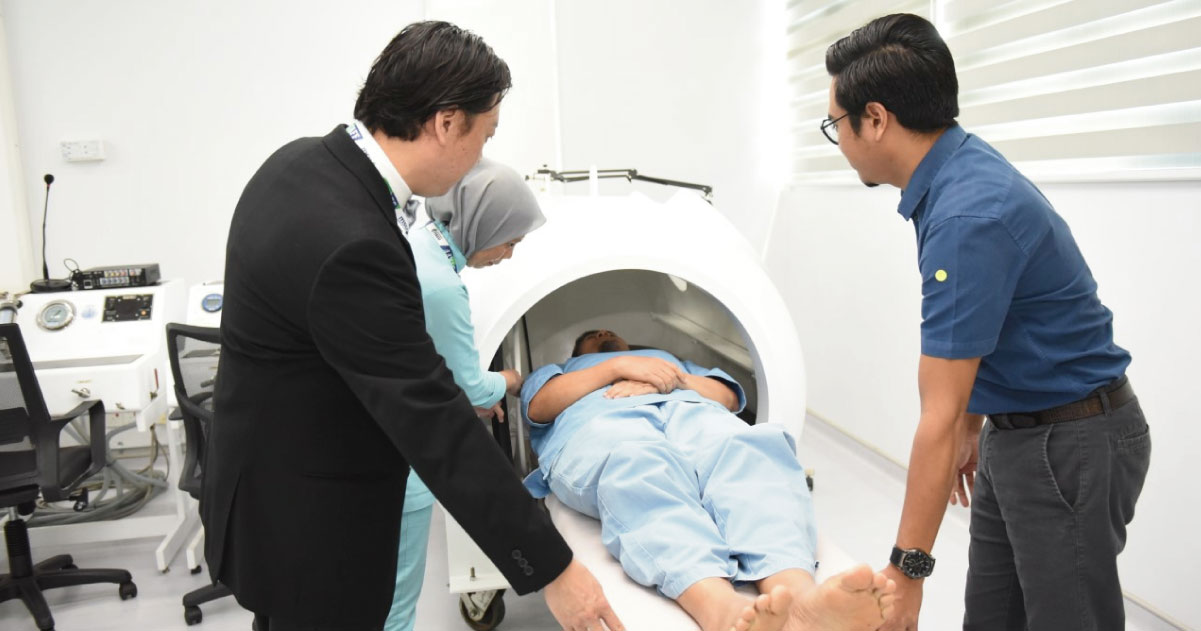

Oxygen has the capability of stimulating white blood cells to mount an attack on, contain, and kill wound bacteria. It also generates superoxide, which is toxic against bacteria.
Good wound-care is crucial to preventing amputation or bacterial blood poisoning in diabetic foot ulcer (DFU), an end-organ damage common to diabetics. Malaysia presents the second highest percentage of diabetics behind Saudi Arabia, with 2015 figures showing one in six Malaysians tested as diabetic.
The world’s number one cause for blindness above accident and trauma, diabetes presents many complications. Whilst high blood sugar causes heart disease or heart attack, low blood sugar can cause arrhythmia (irregular heartbeat). When diabetes is diagnosed, six years are shaved off from one’s life expectancy. If diabetes is diagnosed with cardiovascular disease, twelve years may be lost.
MSU Bachelor in Cardiovascular Technology (Hons)
Whilst seventy percent of diabetics run the risk of a cardiovascular-disease death, one in six will develop DFU. And whilst it takes just one percent drop in sugar level to reduce amputation risk forty-three percent according to a National Health Services study in the United Kingdom, in most cases the wounds can be treated to recovery by combining specialist wound-care with hyperbaric oxygen therapy (HBOT).
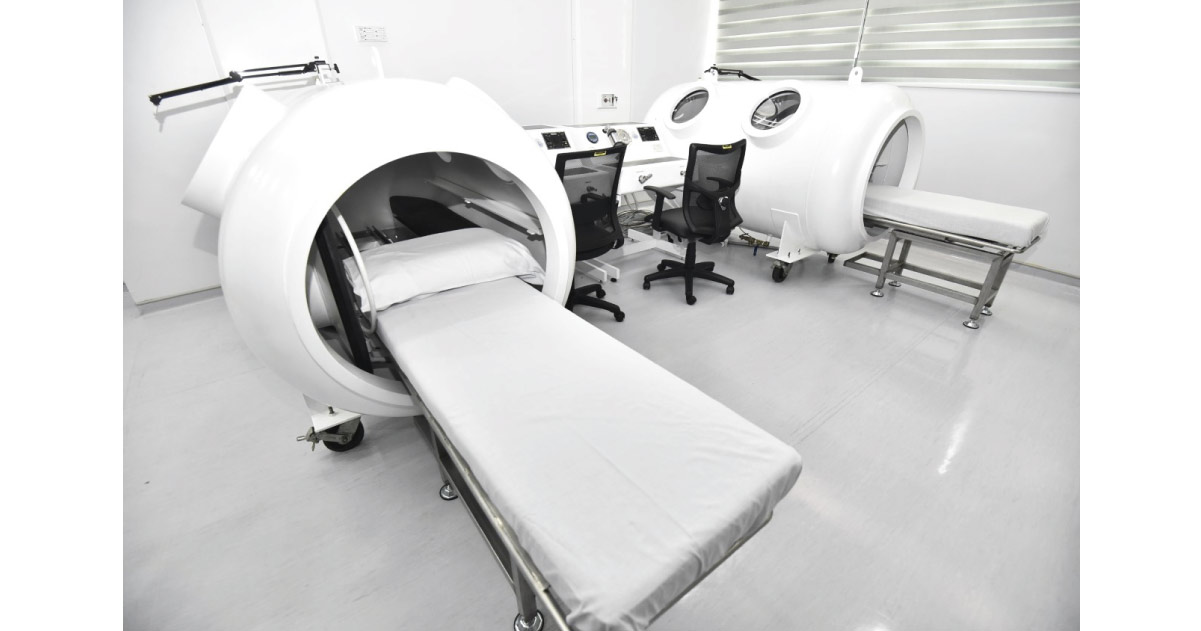
HBOT’s beginnings can be traced to the 1900’s, when technology was advanced enough to extract the twenty-one percent oxygen present in the air we breathe. The term hyperbaric refers to the oxygen delivered in the HBOT chamber being greater than the standard 1,013.25 millibars or 1 bar, i.e., 14.7 pounds per square inch of pressure taken as normal sea-level atmospheric pressure.
MSU Bachelor of Science (Hons) in Mechanical Engineering
HBOT was first used by hospitals to treat decompression sickness (DCS) among people who had to dive underwater and find foundations in bridge-building projects. Too long or too deep a dive, or a high altitude climbed up soon after diving, causes tingling, numbness, and pain on tissues and joints. Left untreated, these symptoms may linger or resurface even years later.
Astronauts may have soon used HBOT chambers to train for extreme conditions before shuttling into outer space, but the most common civilian use of HBOT remains the healing of especially difficult wounds such as DFU.
Particularly effective against anaerobes, HBOT facilitates the oxygen-dependent peroxidase system by which the immune system's white blood cells kill bacteria. It increases the oxygen free radicals that inhibit bacterial metabolic functions.
The hyperbaric pressure of the HBOT chamber ensures every breath inhaled results in the oxygen delivered to fully dissolve in the blood. Not only does it improve blood circulation three times better, the more effective air intake compared with regular breathing under normal atmospheric pressure also makes HBOT the gold treatment standard for carbon monoxide poisoning.
In diabetes-induced organ/tissue damage, HBOT aids growth of new capillaries. The regrowth process, called angiogenesis, can be aided by as few as eight HBOT sessions.
HBOT-aided angiogenesis enhances blood supply and health of heavily irradiated tissues, accelerating healing in post-radiation necrosis (tissue death from cancer treatment’s chemotherapy and radiation). It can also reduce fibrosis and minimize scar-tissue formation, and is as effective for the sick as well as the athletic.
Useful in the healing of minor sports injuries, HBOT is capable of providing holistic care that can benefit the average person; for example, the office worker who sits at the desk all day long and unknowingly develops inflammation. Other known uses of HBOT include post-flight rejuvenations and anti-ageing efforts.
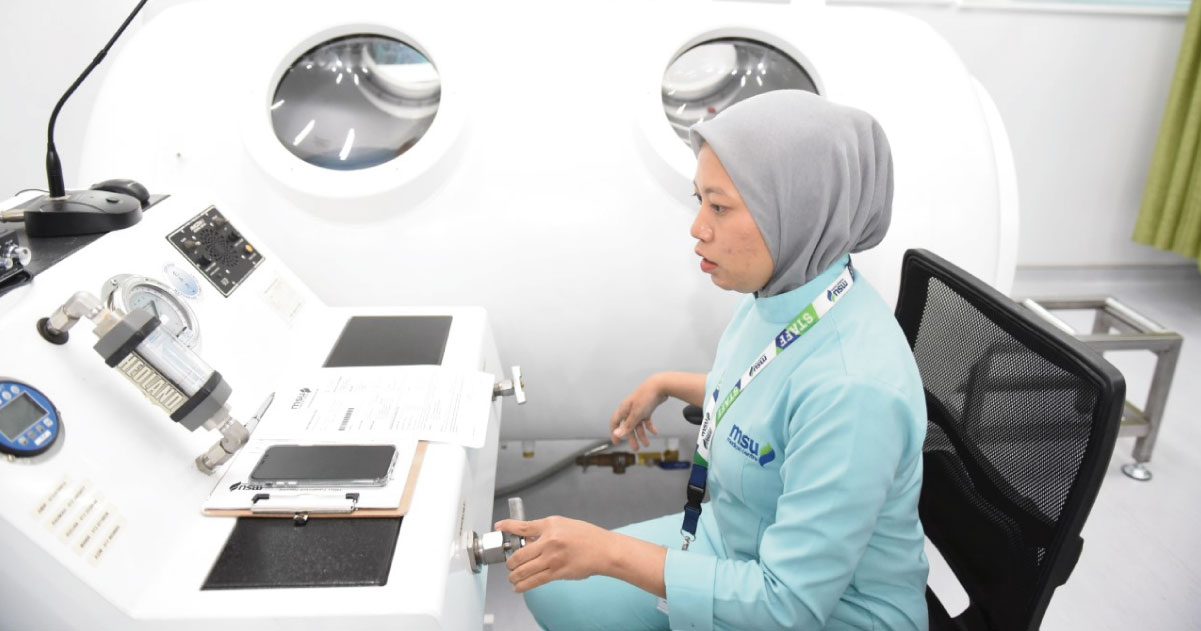
MSU Diploma in Occupational Safety and Health
Management and Science University’s MSU Medical Centre (MSUMC) is one medical establishment that has aided wound healing and prevented amputation through HBOT.
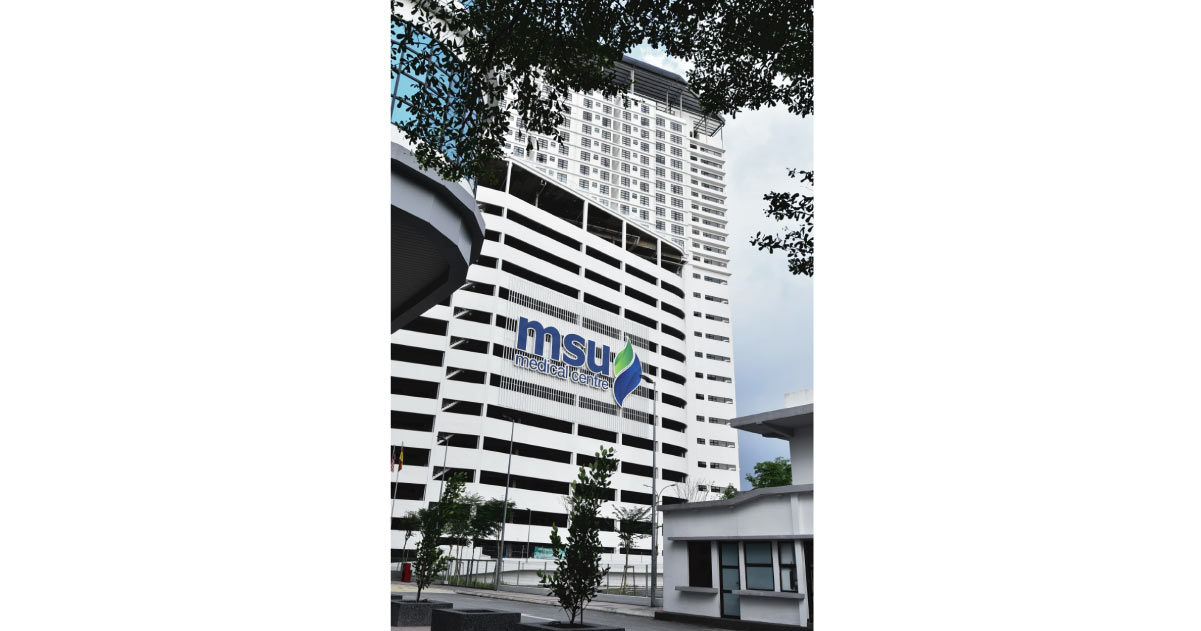
The private specialist hospital purpose-built for the MSU International Medical School (IMS) is equipped to provide the full range of medical services involving hyperbaric oxygen therapy (HBOT), delivered by a hyperbaric physician trained by the Royal Australian Navy and the French Nuclear Submarine Medical Services in Hyperbaric and Submarine Medicine.
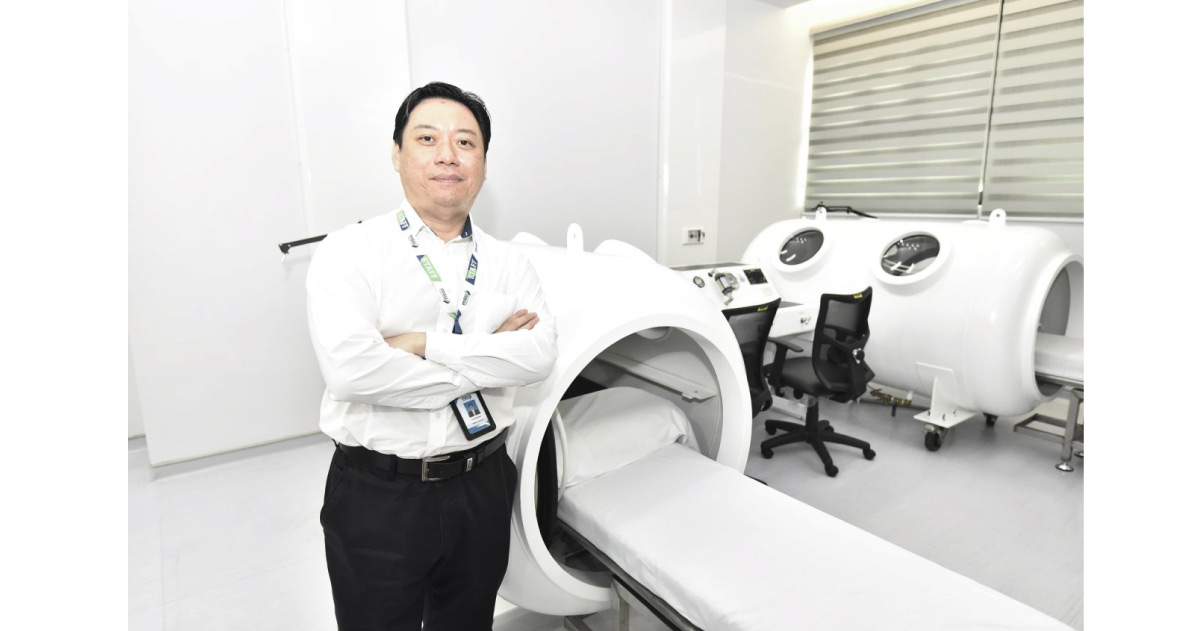
MSU Bachelor of Medicine and Bachelor of Surgery (MBBS)
MSU Bachelor of Medical Sciences (Hons)
MSU Bachelor in Traditional Chinese Medicine (Hons)
MSU Diploma in Medical Laboratory Technology
MSU Diploma in Medical Assistant
MSU Advanced Diploma in Midwifery
Oxygen has the capability of stimulating white blood cells to mount an attack on, contain, and kill wound bacteria. It also generates superoxide, which is toxic against bacteria.
Good wound-care is crucial to preventing amputation or bacterial blood poisoning in diabetic foot ulcer (DFU), an end-organ damage common to diabetics. Malaysia presents the second highest percentage of diabetics behind Saudi Arabia, with 2015 figures showing one in six Malaysians tested as diabetic.
The world’s number one cause for blindness above accident and trauma, diabetes presents many complications. Whilst high blood sugar causes heart disease or heart attack, low blood sugar can cause arrhythmia (irregular heartbeat). When diabetes is diagnosed, six years are shaved off from one’s life expectancy. If diabetes is diagnosed with cardiovascular disease, twelve years may be lost.
MSU Bachelor in Cardiovascular Technology (Hons)
Whilst seventy percent of diabetics run the risk of a cardiovascular-disease death, one in six will develop DFU. And whilst it takes just one percent drop in sugar level to reduce amputation risk forty-three percent according to a National Health Services study in the United Kingdom, in most cases the wounds can be treated to recovery by combining specialist wound-care with hyperbaric oxygen therapy (HBOT).

HBOT’s beginnings can be traced to the 1900’s, when technology was advanced enough to extract the twenty-one percent oxygen present in the air we breathe. The term hyperbaric refers to the oxygen delivered in the HBOT chamber being greater than the standard 1,013.25 millibars or 1 bar, i.e., 14.7 pounds per square inch of pressure taken as normal sea-level atmospheric pressure.
MSU Bachelor of Science (Hons) in Mechanical Engineering
HBOT was first used by hospitals to treat decompression sickness (DCS) among people who had to dive underwater and find foundations in bridge-building projects. Too long or too deep a dive, or a high altitude climbed up soon after diving, causes tingling, numbness, and pain on tissues and joints. Left untreated, these symptoms may linger or resurface even years later.
Astronauts may have soon used HBOT chambers to train for extreme conditions before shuttling into outer space, but the most common civilian use of HBOT remains the healing of especially difficult wounds such as DFU.
Particularly effective against anaerobes, HBOT facilitates the oxygen-dependent peroxidase system by which the immune system's white blood cells kill bacteria. It increases the oxygen free radicals that inhibit bacterial metabolic functions.
The hyperbaric pressure of the HBOT chamber ensures every breath inhaled results in the oxygen delivered to fully dissolve in the blood. Not only does it improve blood circulation three times better, the more effective air intake compared with regular breathing under normal atmospheric pressure also makes HBOT the gold treatment standard for carbon monoxide poisoning.
In diabetes-induced organ/tissue damage, HBOT aids growth of new capillaries. The regrowth process, called angiogenesis, can be aided by as few as eight HBOT sessions.
HBOT-aided angiogenesis enhances blood supply and health of heavily irradiated tissues, accelerating healing in post-radiation necrosis (tissue death from cancer treatment’s chemotherapy and radiation). It can also reduce fibrosis and minimize scar-tissue formation, and is as effective for the sick as well as the athletic.
Useful in the healing of minor sports injuries, HBOT is capable of providing holistic care that can benefit the average person; for example, the office worker who sits at the desk all day long and unknowingly develops inflammation. Other known uses of HBOT include post-flight rejuvenations and anti-ageing efforts.

MSU Diploma in Occupational Safety and Health
Management and Science University’s MSU Medical Centre (MSUMC) is one medical establishment that has aided wound healing and prevented amputation through HBOT.

The private specialist hospital purpose-built for the MSU International Medical School (IMS) is equipped to provide the full range of medical services involving hyperbaric oxygen therapy (HBOT), delivered by a hyperbaric physician trained by the Royal Australian Navy and the French Nuclear Submarine Medical Services in Hyperbaric and Submarine Medicine.

MSU Bachelor of Medicine and Bachelor of Surgery (MBBS)
MSU Bachelor of Medical Sciences (Hons)
MSU Bachelor in Traditional Chinese Medicine (Hons)
MSU Diploma in Medical Laboratory Technology
MSU Diploma in Medical Assistant
MSU Advanced Diploma in Midwifery